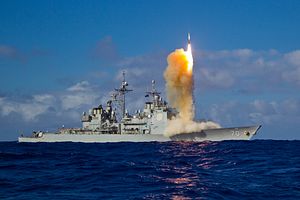Within the space of a week, the United States and China have tested similar ballistic missile defense systems.
The U.S. Missile Defense Agency, with little publicity, tested a Standard Missile-3 (SM-3) Block IIA variant interceptor at the end of January. The test reportedly failed – the second failure of that interceptor type in a year.
Days later, China reportedly test fired a Dong Neng-3 (DN-3) interceptor from its Korla test site, intercepting a Dong Feng-21 missile over Chinese territory successfully. The Chinese test also came shortly after India carried out the fifth known test of its Agni-V intermediate-range ballistic missile.
China’s indigenous ballistic missile defense capabilities are advancing at breakneck speed.
The fundamental technology Beijing has repeatedly showed with systems like the DN-3 is similar to what the U.S. is endeavouring to accomplish with the SM-3 as well as other systems.
Both are so-called ‘hit-to-kill’ systems. They use sheer physical force to collide with and annihilate their targets instead of any explosives. It is far from a simple task, hence the commonly heard comparisons of this form of missile defense with the challenge of hitting one bullet with another.
Beyond their similarities as ‘hit-to-kill’ systems, the SM-3 and the DN-3 are designed to destroy targets outside of the earth’s atmosphere. For a ballistic missile target, both missiles are designed to destroy targets during the so-called mid-course phase of flight. After its engines have burned out, the separated re-entry vehicle is on a ballistic trajectory toward its target.
In the United States, Chinese progress in this area has spilled over into concerns about a prospective anti-satellite capability – and not without good reason. China drew international condemnation in 2007 for using an SC-19 mid-course interceptor to destroy one of its own weather satellites, causing a harmful cloud of debris in space.
In these sorts of direct ascent manoeuvres, systems like the DN-3, the SC-19, and the larger DN-2 can hold U.S. intelligence and surveillance satellites at risk, provided that they pass over Chinese territory. In a conflict, China could hamper the U.S. military’s ability to sustain operations by destroying critical space-based assets using these systems.
Today, ballistic missile defense developments in both countries are a source of great mistrust. In Beijing, there remains concern that the United States is attempting to contain China with a network of ballistic missile defense systems.
The Terminal High Altitude Area Defense (THAAD) system in South Korea, which is aimed at defending against North Korean missiles, swept the headlines in 2016 and 2017, but Chinese strategists are equally concerned about Japan’s exploration of the Aegis Ashore system.
Chinese concerns have less to do with antisatellite capabilities of U.S. mid-course interceptors and more with the United States using a network of East Asia-based radar sensors to enhance its ability to intercept the missiles that form China’s strategic nuclear deterrent.
Beijing’s nuclear strategy is based around a limited nuclear arsenal and a declaratory policy of no first-use. Its nuclear weapons are designed to be available after surviving an enemy’s first strike and offering assured retaliation.
Fears that U.S. ballistic missile defense may render that retaliation ineffective can thus be destabilising. China’s concerns about U.S. networked missile defense in East Asia is overstated, but nevertheless genuine.
Amid all this, the Trump administration is on the cusp of releasing its Missile Defense Review – a document that will come following a record high budget request by the U.S. Missile Defense Agency.
To reduce mutual mistrust and avert the possibility of a spiralling arms race, the United States and China should enter frank discussions on their intentions. The United States had invited China to technical talks around THAAD in 2016, which Beijing rejected. One hopes that there will be another opportunity for the two sides to understand each other’s insecurities.
This article first appeared in the South China Morning Post. It is republished here with kind permission.

































